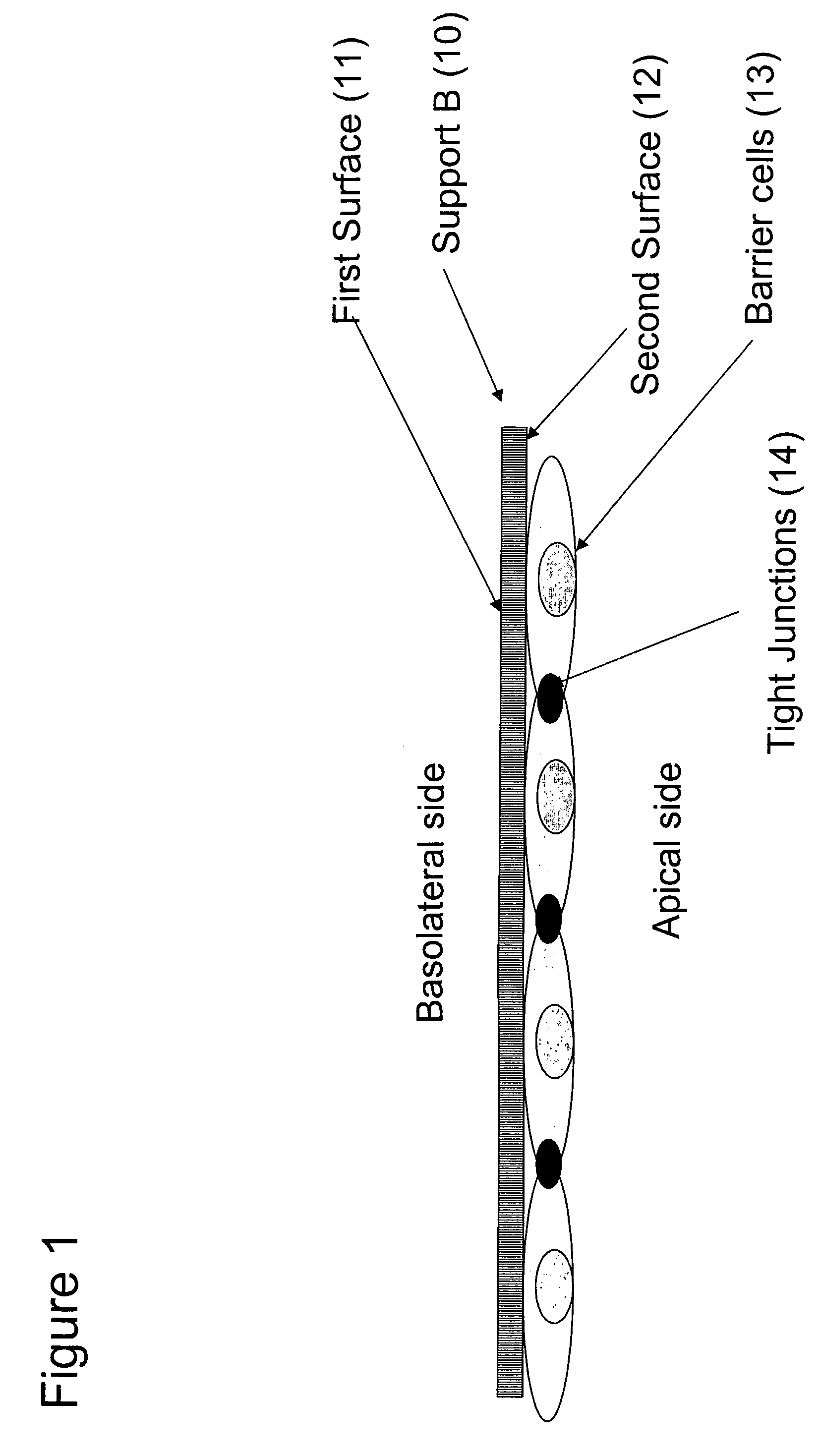Cell Permeability Assay in a Living Array of Multiple Cell Types and Multiple Layers of a Porous Substrate
a cell type and cell permeability technology, applied in the field of cell permeability assay, can solve the problems of limited diffusion of lipids between the apicals, inability to quickly and easily determine whether a particular drug candidate (for instance an organic chemical compound) will be properly absorbed, and high cost and time-consuming process for new drug discovery
- Summary
- Abstract
- Description
- Claims
- Application Information
AI Technical Summary
Benefits of technology
Problems solved by technology
Method used
Image
Examples
example 1
Efficacy of Drugs Penetrating the Blood-Brain Barrier
[0137]To demonstrate an application for the invention in high content screening of drugs designed to penetrate the blood-brain barrier (BBB) and have an effect on targets within cells of the human central neural system.
[0138]A drug library of potential drugs (22) targeted against the central nervous system (CNS) is printed on the support (21) and dried. Drugs are printed as 300 micron diameter spots in an ion exchange polymer such as polyurethane or acrylic resins to slow the drug release upon re-hydration from hours to days. A 5×10 cm sheet of anopore is used, printed with 5,000 drugs or drug combinations to create support layer A (see FIGS. 2 and 3). Alternatively, if the penetration of nutrients to the barrier cells (13) through layer B (10) is sufficient then layer A (21) may be non-porous.
[0139]A barrier cell layer of endothelial and glial cells (13), simulating the BBB, is formed on a second sheet of anopore support (support...
example 2
Antibiotic Penetration Tests
[0144]To demonstrate an application for the invention in high content screening of antibiotic drugs designed to be taken orally then penetrate the intestine wall and kill a pathogenic bacterium within host macrophages.
[0145]A library of vancomycin-related glycopeptides with potential antibiotic activity targeted against the pathogenic bacterium Salmonella typhimurium is printed on the support and dried. Antibiotics (22) are printed as 300 micron diameter spots in gelatine or on support (21) with an altered surface chemistry to slow the drug release upon rehydration to a few hours. A 5×10 cm sheet of glass is used, printed with 5,000 drugs or drug combinations to create layer A (see FIG. 2).
[0146]A mammalian cell layer of Caco2 cells (13), simulating the intestinal barrier, is formed on a sheet of anopore support (support B) (10). Important characteristics of this layer are noted in Example 1.
[0147]Low-passage-number cultured J774 macrophages cells (16) ar...
PUM
| Property | Measurement | Unit |
|---|---|---|
| pore diameter | aaaaa | aaaaa |
| pore diameter | aaaaa | aaaaa |
| pore diameter | aaaaa | aaaaa |
Abstract
Description
Claims
Application Information
 Login to View More
Login to View More - R&D
- Intellectual Property
- Life Sciences
- Materials
- Tech Scout
- Unparalleled Data Quality
- Higher Quality Content
- 60% Fewer Hallucinations
Browse by: Latest US Patents, China's latest patents, Technical Efficacy Thesaurus, Application Domain, Technology Topic, Popular Technical Reports.
© 2025 PatSnap. All rights reserved.Legal|Privacy policy|Modern Slavery Act Transparency Statement|Sitemap|About US| Contact US: help@patsnap.com



